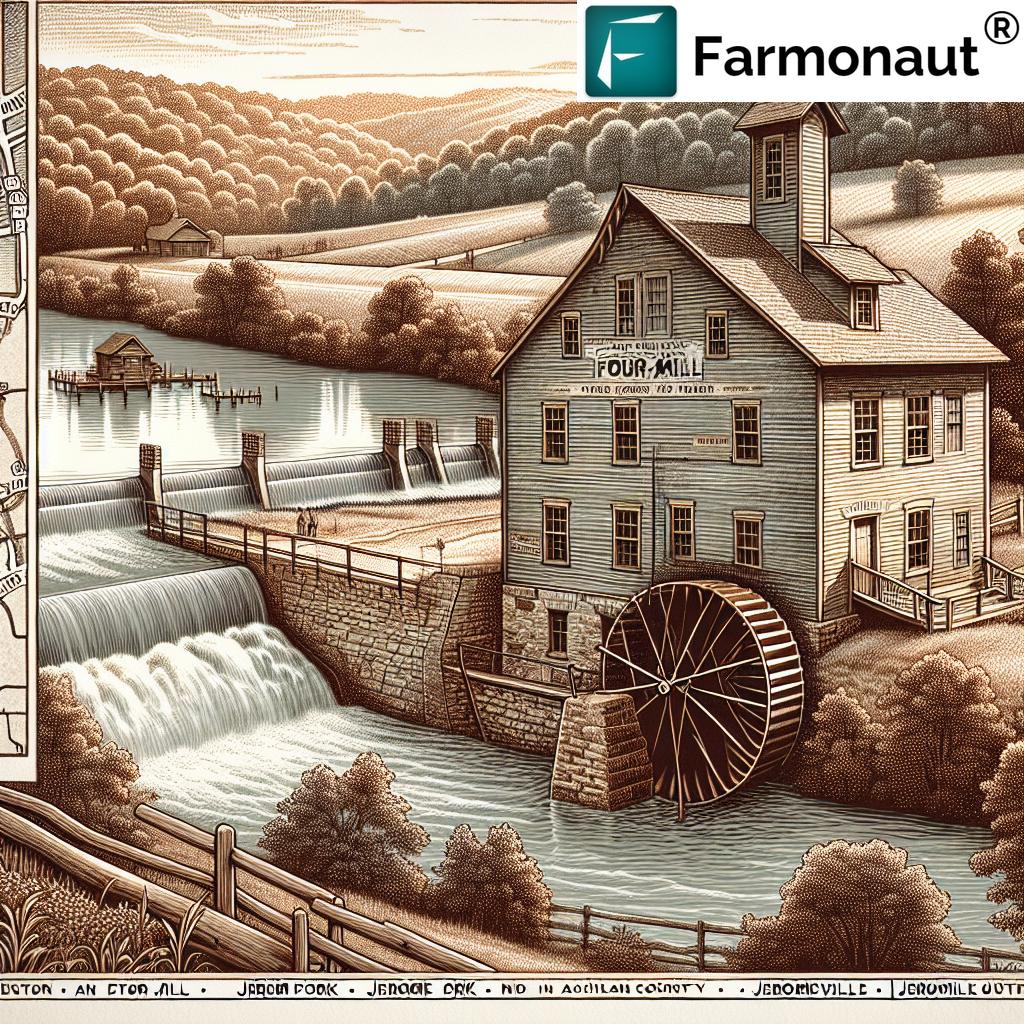7 Fascinating Facts About Jeromesville, Ohio’s Historic Village
“Jeromesville was founded in 1815, making it over 200 years old and one of Ashland County’s earliest villages.”
Introduction to Jeromesville, Ohio’s Historic Village
Jeromesville, nestled in the heart of Ashland County, Ohio, is a living testament to the enduring spirit and history of the American Midwest. Recognized as one of the oldest and most storied villages in Ashland County, Jeromesville offers a captivating journey through time—dating all the way back to its founding on February 14, 1815. Surrounded by the gentle landscapes near the Jerome Fork, this village is not just a dot on the map but a vibrant community infused with the history, culture, and values that define rural Ohio.
In this exploration of Jeromesville Ohio history, we’ll uncover the fascinating stories of early settlers, the influence of the Mohican Native Americans, iconic landmarks, pivotal events, and the continuing vibrancy of village life in Ashland County. Whether you are a resident, a history buff, or a visitor searching for things to do in Jeromesville, this guide will deepen your appreciation for this historic village’s unique charm and enduring legacy.
1. The Rich Roots of Jeromesville Ohio History
The roots of Jeromesville Ohio history run deep, entwining with the greater story of the American Midwest and Ohio’s early development. When Ohio became a state in 1803, the area which would become Jeromesville was still wilderness, traversed primarily by Native Americans and a few intrepid fi frontiersmen.
Founding and Early Surveying
The village of Jeromesville (originally spelled “Jeromeville”) was formally established in 1815 by Christian Deardorff and William Vaughn. Deardorff purchased land from Jean Baptiste Jerome, who had settled in the territory following his involvement in the Battle of Fallen Timbers. Our village was thoughtfully plotted and named in honor of its influential settler, Jerome, an emblem of the blending of French, Native American, and early American influences.
The Jerome Fork, a key natural resource, attracted both Native settlements and pioneer families. The banks of the Jerome Fork not only provided abundant water supply for people and animals, but also served as a lifeline for industry, with mills harnessing the water’s power for growth and prosperity.
A Legacy of Resilience
From its birth, Jeromesville has prevailed through fires, floods, and the changing tides of American life. The historic buildings in Jeromesville still standing—such as the tavern built by Richard Hargrave in 1818—anchor our collective memory, connecting present-day residents to the triumphs and trials of our forbearers.
2. Early Settlers and the Mohican Influence on the Village
Before Jeromesville emerged as a bustling settlement in Ashland County, the area was home to a thriving Native community known as Mohican Johnstown. Built as early as 1762, this village stood west of the Jerome Fork on a knoll, featuring a council house and up to eighty pole lodges. The Mohican Indians cultivated the nearby bottomlands, benefiting from the region’s rich soil and ready water supply.
Jean Baptiste Jerome—the eponymous settler—established his homestead alongside Native American families, marrying into the community and engaging in trade, farming, and trapping. His log cabin became a local landmark of peaceful coexistence and economic exchange between early settlers and Native peoples.
The early settlers in Ohio were drawn to this area due to its strategic location along trails and proximity to water. However, as Americans moved west and the War of 1812 led to the removal of local Indians, the demographic complexion of the village changed dramatically, ushering in an era of new growth, conflict, and cooperation.
The Blockhouse Legacy
During the tumultuous years of the War of 1812, soldiers under General Reasin Beall built a blockhouse for protection on a nearby knoll. This fortification made it possible for settlers to withstand Indian uprisings and threats within the original village area. The presence of a spring inside the blockhouse allowed families and animals to survive extended conflicts. This symbol of resilience and ingenuity remains celebrated in local lore and underscores the importance of mutual support and preparation among early Jeromesville residents.
3. Village Life in Ashland County: The Making of a Community
From our earliest days, village life in Ashland County has been defined by close-knit relationships, practical resourcefulness, and a shared vision for the future. As Jeromesville grew, so too did the number and activity of civic organizations, churches, and businesses that stitched families and traditions together.
The Importance of the Town Square
The Jeromesville town square quickly became the heart of community activity. Early photographs show a bustling hub, with the Ewing Hardware (general store) at its center—later succeeded by the present-day Jeromesville Market and other essential businesses. Main Street was home to lively gatherings, commerce, and the sharing of local news that fostered unity and belonging among village residents.
A Community Shaped by Fire and Rebuilding
Fires periodically destroyed key landmarks, including the Ewing Hardware (1901) and the replacement building in 1931. Despite these setbacks, the community’s determination ensured each site was rebuilt or repurposed, a testament to our town’s enduring spirit. The remaining historic buildings in Jeromesville speak to generations who refused to let disaster define their lives.
Clubs and Civic Organizations: The Backbone of Village Spirit
Civic pride runs deep. Jeromesville Lions Club, American Legion Post 749, the Sons of the American Legion, Troop 521 (Boy Scouts of America), Hilltop 4-H’ers, and Jeromesville Youth League still serve as engines of communal support and development. With annual events like the Jeromesville Homecoming, Memorial Day Parade, and Christmas concerts, our organizations perpetuate cherished traditions and shape the modern identity of Jeromesville.
For those seeking things to do in Jeromesville, these events, along with family-friendly parks and local sports, provide meaningful opportunities to connect and participate in our vibrant cultural calendar.
“The village’s population peaked at 562 residents in the 2020 census, reflecting its small-town historic charm.”
4. Historic Buildings in Jeromesville and Their Legacy
Our historic buildings are time capsules preserving eras of hope, growth, and perseverance. Among the most notable structures in the village are:
- Main Street Tavern: Built in 1818 by Richard Hargrave, it was the first tavern west of the Allegheny Mountains and remained in operation for an astounding 75 years. Still standing across from the current bank, this is the oldest building in Jeromesville—a must-see for any history enthusiast exploring Ashland County historic villages.
- Fickes Furniture Store (Former Schoolhouse): The former two-story, frame and brick school building, originally built after a mysterious fire destroyed its predecessor in 1889. The bricks for the rebuilt structure were supplied by Ridgley’s kiln, illustrating both the practical and communal approaches to construction in the past.
- Jeromesville Market: The present market stands on the historic town square, adjacent to where the notable hardware store (Carl Hardware, later Bodager Hardware) also remains.
- Mills Along the Jerome Fork: The original village boasted vital mills powered by the Jerome Fork dam, producing flour and other goods for local use and trade.
Time and again, fire and flood threatened these landmarks, but our ancestors’ decision to rebuild ensured that their architectural and community spirit would endure and inspire future generations.
Preservation and Modern Use
Many historic buildings in Jeromesville have found new life through adaptive reuse, now serving as businesses, public offices, or private homes. This vibrant connection between past and present is central to the appeal of Jeromesville as one of Ohio’s best-preserved historic communities.
Tip: For visitors, the main street area offers a rewarding walking tour to admire these living pieces of Jeromesville Ohio history while experiencing authentic village hospitality.
5. The Story of Jeromesville Schools and Education
Education has always been a cornerstone of our community. As early as the village’s founding, Jeromesville citizens worked together to provide quality schooling for their youth—reflecting the importance of knowledge and opportunity to both settlers and later generations.
From Log Cabin to Modern Education
Classes began in a modest log building near the present Jeromesville Cemetery. As the student population grew, a new, two-story frame building was constructed just east of today’s Fickes Furniture Store. After that building was destroyed by fire in 1889, the surviving brick schoolhouse was quickly rebuilt—and its bricks highlight the centrality of local labor and material supply traditions.
In the early 20th century, a growing village population led to the creation and expansion of a new elementary school on the site of the current town park. This new space soon required additional classrooms and eventually gave way to the iconic Jeromesville School—the structure now home to Hillsdale Middle School—built in 1927. The lettering atop the building still bears the original misspelled “Jeromeville School,” a unique quirk cherished by generations of students and residents alike.
The modern educational system in Jeromesville is part of the renowned Hillsdale School District. Established from the consolidation of Jeromesville and Haysville districts in 1961, Hillsdale adopted “Falcons” as its mascot, with Columbia blue and gold as defining school colors.
Jeromesville Schools and Education: Fast Facts
- Initial students attended a small log cabin school in early 1800s.
- Brick schoolhouse built and expanded; now houses Fickes.
- Enrollment peaks led to continuous upgrades and expansion.
- Modern Hillsdale Middle and High School as community anchors for sports, music, and civic pride.
6. Churches in Jeromesville Ohio – Pillars of Community
Churches in Jeromesville Ohio have always played a foundational role in the cultural and social fabric of the village. Three historic congregations stand as testaments to the enduring values of faith, fellowship, and mutual support:
- United Methodist Church: Located within the village and active in numerous spiritual and community initiatives.
- Trinity Evangelical Lutheran Church: Anchoring generations of Lutheran tradition within the Ashland county area.
- Jeromesville Christian Church: Fostering interdenominational unity and outreach across the community.
Each of these churches has contributed to education, charity, event organization, and spiritual sustenance. Many of Jeromesville’s community events—including seasonal concerts, fundraisers, and welfare activities—are coordinated in partnership with these churches, exemplifying the power of faith-driven civic action.
7. Community Organizations, Events, and Modern Vibrancy
Although Jeromesville’s population remains modest (noted at 562 residents in the 2010 census), the vibrancy of our village life in Ashland County is nothing short of inspiring. Our civic organizations, active clubs, and annual events reflect the deeply-rooted sense of place and purpose still present in the village today.
Leading Civic Organizations
- Jeromesville Lions Club: Established in 1944, instrumental in co-sponsoring the Jeromesville Homecoming and numerous local charitable activities.
- American Legion Post 749 & Sons of the American Legion: Active for over 50 years, vital in organizing Memorial Day and Veterans Day ceremonies, as well as children’s events like the annual Easter Egg Hunt.
- Jeromesville Community Fire Department: Beyond protecting life and property, members host chicken barbecues, community safety demonstrations, and more.
- Troop 521, Boy Scouts of America: Chartered since 1944, Troop 521’s Eagle Scout projects—such as the 2015 historical marker—continue to enrich our village’s heritage and spirit.
Dozens of other initiatives, from 4-H youth programs to the Jeromesville Youth League (baseball and softball), foster intergenerational bonds and create meaningful Jeromesville community events throughout the year. Civic engagement and the willingness to “support our own” remain fundamental values.
Present-Day Vitality
As new challenges and opportunities emerge, our village continues to adapt—whether by modernizing infrastructure, supporting schools and local agriculture, or organizing community events that bring families together. Jeromesville stands as a living example of Ashland County historic villages where the past, present, and future remain interconnected.
Historic Timeline Table: Jeromesville, Ohio
| Year/Period | Event or Landmark | Description | Estimated Impact/Population |
|---|---|---|---|
| 1762 | Formation of Mohican Johnstown | Mohican Indian village with 60–80 lodges established west of Jerome Fork | ~200 inhabitants |
| 1795 | Settlement by Jean Baptiste Jerome | French-Canadian trapper and family settle along Jerome Fork, farming 30-40 acres | Small family farm |
| 1812 | Blockhouse Built | For protection during War of 1812; Captain Murray in charge | Community safety, no casualties reported |
| 1815 | Village of Jeromesville Founded | Land purchased, village lots officially plotted & named after Jerome | ~20 families settled |
| 1818 | Main Street Tavern Built | Richard Hargrave opens tavern; oldest building, business remains for 75 years | Hub for travelers and locals |
| 1836 | First Mill Established Along Jerome Fork | Flour and sawmills powered by water from the Jerome Fork dam | Agricultural economy growth |
| 1889 | School Fire & Brick Rebuild | Original two-story school destroyed by fire; replaced with brick (now Fickes Furniture) | ~80 students affected |
| 1901/1931 | Town Square Fires | Hardware/general store destroyed twice by fire; rebuilt each time | Multiple businesses replaced |
| 1913 | Great Flood of Ohio | Jerome Fork overflows, village experiences major flooding | Widespread property damage |
| 1927 | Current School Building Constructed | Jeromesville School built (now Hillsdale Middle School) | Capable of 135+ students |
| 1961–65 | Hillsdale School District Founded | Jeromesville unites with Haysville, founding Hillsdale High School | Modern educational services for area |
| 2010 | Population Census | Village reaches population of 562 residents | Modern peak population |
| 2015 | Village Bicentennial | 200th anniversary celebrations; Eagle Scout projects add historic markers | Continued town pride |
Farmonaut: Precision Agriculture to Support Local Farmers
As we celebrate the resilience and heritage of Jeromesville and its historic villages in Ashland County, it’s crucial to highlight how modern advancements can further empower our community, especially in the field of agriculture. Farmonaut, a leading provider of satellite-based agricultural solutions, is transforming farming both globally and locally by making precision agriculture accessible and affordable for all.
Farmonaut Technologies: A New Era for Jeromesville & Ashland County Agriculture
- Satellite-Based Crop Monitoring: Get real-time insights into crop health (NDVI), soil moisture, and growth trends to optimize yields and reduce resource use—directly from your smartphone or browser. This is perfect for monitoring field health and making informed irrigation and fertilization decisions, even when miles away.
- Jeevn AI Advisory: Our AI-driven platform delivers expert, real-time advice to farmers, allowing smarter, evidence-based crop management for Jeromesville lands and beyond.
- Blockchain Product Traceability: Enhance trust and transparency with blockchain-powered documentation of product journeys from Jeromesville’s farms to the consumer’s table—vital for local landowners and larger supply chains alike.
- Fleet & Resource Management: Keep track of every tractor, truck, and tool with Farmonaut’s intuitive fleet management system. Lower costs, maximize uptime, and safeguard your investments.
- Carbon Footprinting: Monitor emissions and make eco-friendly changes, ensuring Jeromesville’s agricultural sector stays competitive and sustainable.
With a flexible subscription model, Farmonaut serves everyone—from individual Jeromesville family farms to large Ashland County agribusinesses and government agencies.
Explore our API and Developer Docs for seamless integration with your existing systems.
Farmonaut is devoted to supporting early settlers’ spirit through modern technology—helping families continue their traditions with 21st-century efficiency, insight, and sustainability.
Frequently Asked Questions about Jeromesville, Ohio
What are some must-see historic buildings in Jeromesville?
Visitors and historians should make time to see the Main Street Tavern (the oldest standing building), the former Fickes Furniture Store (built of local brick on the site of the 19th-century schoolhouse), and the Jeromesville Market. Walk along Main Street to experience the core of the historic village.
How did the Jerome Fork dam and mills shape local industry?
The Jerome Fork dam powered both a flour mill and sawmill, helping the village grow economically by supplying essential goods and supporting the agricultural community for over a century.
What are the top Jeromesville community events?
Highlights include the Jeromesville Homecoming, Memorial Day Parade, Christmas concerts, and a series of youth sports and scouting events organized by local clubs and churches. These events foster the traditional village spirit.
Where can I find more about local education and schools in Jeromesville?
The Hillsdale School District website as well as village archives offer a wealth of information about Jeromesville schools and education. The historic Jeromesville School building still stands as a testament to the area’s educational dedication.
How can Farmonaut help farmers near Jeromesville, Ashland County?
Farmonaut’s solutions—such as satellite-based crop monitoring, carbon footprint tracking, blockchain traceability, and resource management—empower farmers to maximize yield, operate efficiently, and achieve sustainability, all while honoring the agricultural legacy of Jeromesville. Sign up here or use our API for advanced farm management.
Conclusion: A Living Legacy in Ashland County
Jeromesville is more than just another village in Ashland County, Ohio. It’s a narrative of resilience, innovation, and timeless community spirit. From early settlers and Mohican heritage, through historic fires and floods, to modern technology and active civic organizations, this village remains a glowing example of the American ability to honor the past while forging the future.
As we seek new tools—like those offered by Farmonaut—to keep our farms competitive and our land sustainable, Jeromesville’s story is alive in every classroom, church, historic building, and community event. We invite everyone to engage with local history, participate in vibrant village life in Ashland County, and ensure that Jeromesville continues to shine as a beacon for generations to come.
Whether you are a village resident, a history enthusiast, or a visitor seeking unique things to do in Jeromesville, our history, community, and advancing agricultural practices await you with open arms.






















